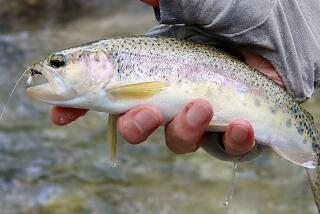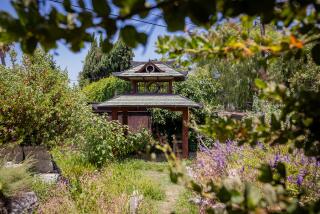Second Nature
- Share via
Perhaps 20 years ago, a man named Roland Case Ross--a retired Cal State professor--decides he’s going to restore Pasadena’s stretch of the Arroyo Seco, about a mile south of the Rose Bowl. Ross knows the arroyo’s stream was channelized for flood control in the 1930s, its banks lined with 15-foot cement walls that killed off the canyon’s wet riparian woodland. Ross owns a hoe and, environmentally speaking, a holistic philosophy. He plants indigenous flora along the channel, trees found there at the turn of the century, when you could pull 30 trout in two hours from the stream. But gophers kill every sapling he puts into the ground, and he becomes discouraged as his project founders. Not long after, Ross dies.
Six years ago, the giant waste-hauling company Browning-Ferris Industries fulfilled a condition of expanding its landfill operations by agreeing, in effect, to implement Ross’ dream--now a shared fantasy down at Pasadena City Hall. But BFI owns more than a hoe and did Ross one better: It lifted the arroyo’s stream out of its flood channel and carved a new, “natural” stream bed into the canyon floor.
BFI turned to science. The “channel morphology” of the new stream, it noted in a report, would be a “broad, cobbled streambed” displaying a “sinuous pattern,” with water flows regulated at “5-10 cubic feet per second,” the plantings exactly “4.2 acres of streamzone species,” and no less than “22.4 acres of riparian, woodland and associated meadow species.” Gophers would be monitored, $5 million spent. All this and more was done, and on April 15, a valve beneath the Colorado Street bridge was opened and the second Arroyo Seco stream poured forth. At that point, science stopped and nature took over.
A couple weeks ago, a biologist named Mickey Long--an old friend and former champion of Roland Case Ross--walked the banks of the Arroyo Seco stream. Long pointed out Arroyo willows, cattails, mulefat and umbrella sedge, some of which was post-BFI, brought in by air or water current. “It’s not as easy as just bulldozing a channel to create a stream,” Long said, looking over a still pool, “but it is true that if you bring the water, they will come.”
And there they were, assembled plein-water: colonies of aquatic snails, two species of frogs, schools of small fish darting through larger pools, every stream bug imaginable. Near the headwaters, a pair of mallard ducks floated across a quiet stretch by a white alder. How they had each arrived, however, made science stutter. BFI had pored over archival photographs of the early arroyo when it made its plant and channel morphology choices. But there was no record of the secret life of vertebrates and invertebrates, and no one knew, exactly, what would happen when water was restored. Would life systems just magically arrange themselves? In a former dusty field of weeds, within a period of three months, that is what seems to have happened in the Arroyo Seco.
A house finch landed nearby and Long said, “You know, Ross’ secret dream was always to blow up the concrete channel.” For a long time in the 1970s, Ross tried to interest Pasadena in nonexplosive options of Arroyo Seco restoration, but they considered him an unusual fellow and ignored him. “This is not as holistic as Ross would have wished,” the biologist said as the finch took a drink. “But generally, I think he would have liked it.”
More to Read
Sign up for Essential California
The most important California stories and recommendations in your inbox every morning.
You may occasionally receive promotional content from the Los Angeles Times.










